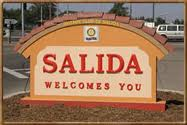 The City of Modesto’s positions on Wood Colony and Salida have become two of the most divisive issues in the region. One of the sources of the controversy is differing views about Stanislaus County’s role in promoting urban sprawl. Garrad Marsh, John Gunderson, and Bruce Frohman have long been acutely sensitive to the County’s potential threats to farm land. Here, Bruce establishes the historical context for fears that the County could supplant cities as the major promoter of urban growth.
The City of Modesto’s positions on Wood Colony and Salida have become two of the most divisive issues in the region. One of the sources of the controversy is differing views about Stanislaus County’s role in promoting urban sprawl. Garrad Marsh, John Gunderson, and Bruce Frohman have long been acutely sensitive to the County’s potential threats to farm land. Here, Bruce establishes the historical context for fears that the County could supplant cities as the major promoter of urban growth.
The purpose of the Stamp Out Sprawl Initiative (SOS) is to establish urban limit lines in order to prevent sprawl and preserve farm land. Given the recent history of Stanislaus County and current development agreements, there’s a possibility that SOS could do more harm than good.
History
In the 1980’s, Stanislaus County had a major growth spurt. Developers were tripping over each other to expand urban boundaries. Houses and shopping centers proliferated. Most of the growth went into the cities, but Stanislaus County government wanted a piece of the action to gain tax revenue.
To name two examples, Stanislaus County allowed the North Modesto Industrial Park outside of Modesto’s City limits but within the city’s sphere of influence. The County also allowed all of Modesto’s car dealerships to move to North McHenry Avenue, outside the city limits.
These developments siphoned tax revenues away from the City of Modesto and into County coffers. This taking of tax revenues created a lasting ill will between the leaders of the County and the City of Modesto. All sorts of legal actions were contemplated.
In a moment of compromise, County leaders met with City leaders and agreed to split sales tax revenues from auto sales. More importantly, the County agreed not to approve any more urban development within Modesto’s sphere of influence without Modesto’s approval. Only Modesto can ultimately decide what urban development will be allowed within its sphere.
The Current Layout
Modesto has sought to expand its sphere of influence. If it adds Wood Colony, then Modesto can control land use in that area. The purpose of a sphere of influence is to claim a land area for future urban development and annexation into the City. If Modesto successfully added Wood Colony, the area could be developed. If SOS passes, Modesto could still add Wood Colony to its sphere of influence, but would not be able to urbanize the area without a public vote.
Modesto previously laid claim to large areas around Salida, specifically in the triangle south of Salida, and all the land east and northeast of Salida. Those areas are within Modesto’s sphere of influence and are slated for eventual urban development. However, the areas will only be developed if Modesto decides that it wants to.
Potential Adverse Impact of SOS Initiative
If urban limit lines are established by initiative, the new law has the potential impact of negating the agreement with Stanislaus County to not develop within Modesto’s present sphere of influence.
If SOS is approved, an argument can be made that Modesto had decided not to develop the land outside of the urban limit boundaries. Therefore, if another political jurisdiction wants to develop the land, it may be open season on development.
If Salida incorporates, the new city could mushroom onto farm land presently in Modesto’s sphere of influence. If it does not incorporate, Stanislaus County could continue approving developments as it has already done along Freeway 99 and the Kiernan Expressway
Are Concerns Justified?
When Jeff Grover was County Supervisor, he created the Salida Plan. The map he created envisions urban development by a future incorporated city of Salida that extends from Freeway 99, north of Modesto’s boundary, east to McHenry Avenue. The City of Riverbank would take all the land east of McHenry Avenue. Agriculture would be squeezed into extinction.
If Modesto establishes urban limit lines, the Stanislaus County Board of Supervisors could interpret the lines as an abandonment of the sphere of influence, opening up full implementation of the Salida Plan.
Would the Board of Supervisors Allow All that Development?
Periodically in Stanislaus County, county government has promoted urban sprawl as enthusiastically as any city has. The position of the county depends on who is on the board.
When Supervisor Jeff Grover was in office, he told me that Stanislaus County only grows luxury crops and that he believed urban development should extend all the way out to the county line. Imagine the impact on agriculture if a majority of supervisors thought the same way.
The Cause for Pessimism
Having witnessed the growth of urban sprawl in Stanislaus County since 1980, I don’t see an easy fix for the relentless incremental taking of farm land. Absent the resolve of elected leaders countywide to permanently set aside land for agriculture, measures like SOS may have some beneficial impact. However, SOS could make the problem worse.
Moneyed interests always seem to carry more sway than the desire of voters. If someone with deep pockets wants to do an urban development, lines on a map won’t necessarily be able to stop it. If a city won’t allow it, maybe the County will.

True to form, Bruce has become the master of the negative. My friend has become a beacon of horror on this Halloween night. Hard to see behind the mask to tell the difference between his nativity and his deception.
Sorry you feel that way Denny. I look forward to reading your opinion piece about how SOS will solve all our problems.